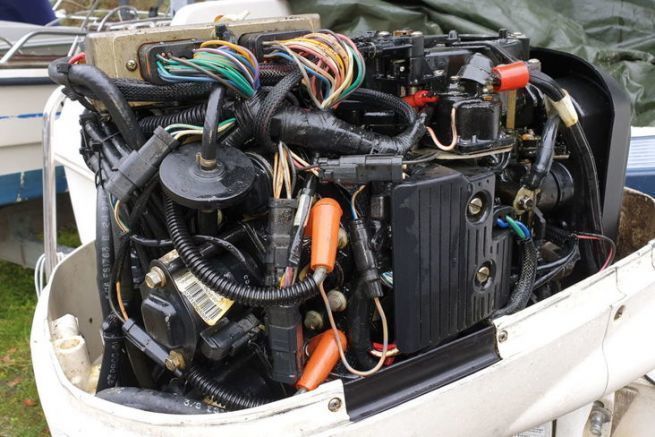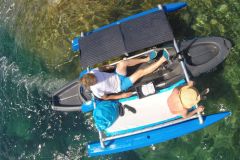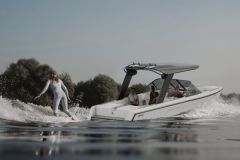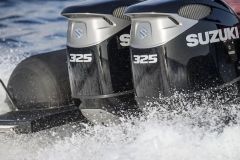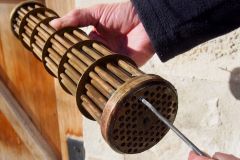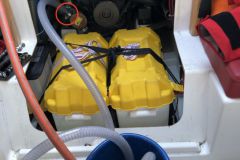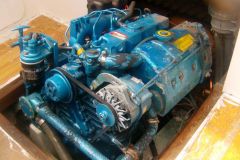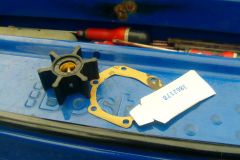Getting back on the water means fun and relaxation, a day with friends and family. Everything is ready, cooler on board and ice in the freezer. You proudly start the engine and suddenly things aren't going as well as they should. Your first instinct is to smile for a moment. And to think about the problem.
Good idea, we help you in this search for failure.
1 - The fuel shortage
Certainly the number one reason for engine failure. Surely, you are not one of those who run out of gas. You know your engine's consumption to the nearest half-litre and know how much fuel is left in the tank. What's more, the gauge indicates that it is completely full. However, this time it is clear that the tank is dry.
Solution: Fill the tank before each trip and make sure the gauge is actually working, checking that it drops as you sail.
Prevention: Apply the rule of thirds:
- One third of the tank for the outbound route,
- One third for the return route,
- One third for bad weather.
2 - Power loss
The engine suddenly starts to jerk. It stops running smoothly and its power decreases. But there's fuel in the tank. Don't look, one of your filters is clogged or a spark plug is tired.
Solution: Obviously, replace the responsible filter with a new one, which you will have taken the precaution of taking on board. Forgot to bring it? Try to clean it by removing any debris, dirt, bugs, etc. that could clog it. Collect the water from the bowl of the decanter filter on the boat's supply line in a container that you will empty on land in a designated area.
Prevention: Fuel is usually of good quality, but prolonged storage - both diesel and gasoline - will soon cause it to deteriorate and mix with water in the fuel tank. Once you have filled up the tank, as soon as you know you will not be using the boat for a few weeks, add an additive that will prevent this degradation.
If the fuel is not to blame, the spark plugs certainly are. On gasoline engines, they are used to cause the spark that will explode the air/fuel mixture.
Solution: You have replacement spark plugs on board. Remove the spark plugs from the engine one by one and, if you suspect a problem, replace the offending plug.
Prevention: Change spark plugs once a season. Always have a full set of spark plugs in the on-board toolbox.
3 - The engine does not start
When you turn the key, nothing happens or the engine runs, but in a sluggish way.
Solution: In the first case, check that the circuit breaker is turned on, that the starter switch is not disconnected or, more commonly, that the throttle is in the "on" position neutral .
In the second case, either the battery is discharged or a cable is not tight.
Prevention: Regularly check the tightness of all the motor's power cables. Have a battery voltage indicator and limit the use of electricity when anchored. As soon as the battery voltage drops below 12.5 volts, unplug everything that uses electricity.
Ideally, install a service battery for these needs and keep the starter battery dedicated to this single task.
4 - The engine heats up
The temperature gauge flies up. It is apparent that the engine is not cooling. Most of our boat engines use the water in which they run to cool themselves. If that water runs out, the engine heats up.
Solution: Most often, algae, leaves or other debris have clogged the motor's water intake screen. Simply remove them from the intake.
Prevention: Before each trip and on your return, inspect the cooling water intake and remove any debris. Once a season, replace your engine's intake fan. Finally, when you start an outboard motor, always check that the " pissette The "action" button is pressed.
5 - The motor stops working
Don't worry, in most cases, the kill switch has disengaged and can simply be put back in place. More annoyingly, you are out of fuel. A faulty electrical connection (fuse, battery terminals ...) can also be the cause of this malfunction.
Solution: Start with the common scenario: the kill switch. Review the remaining fuel. Then check the electrical connections, first to the battery and then up the line, starter, alternator, spark plugs and check, at each step, that the connections do not move ( vibrations have a deleterious effect on electrical connections ) and that they show no trace of oxidation. This is especially true for the battery, which will oxidize briefly due to the presence of acid.
Prevention: Tighten cables and terminals regularly. Remove all traces of oxidation from the battery terminals and brush them with grease to protect them. Always have a pot of grease on board to intervene during navigation.
6 - The engine vibrates
The more you accelerate, the more the engine vibrates or the engine actually runs, but the boat slows down.
Solution: Something is wrong with the propeller. Like car wheels, the propeller transmits motion to the boat. It could be a fishing line wrapped around the propeller, or a blade bent after an impact. In both cases, the only reasonable thing to do is to return peacefully to a safe anchorage to try to put everything back in order. In the worst case, it could be a broken propeller after a shock.
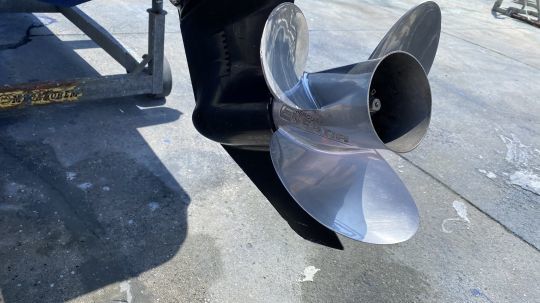
In this case, unless a safe anchorage is immediately available, a request for assistance should be considered.
Prevention: Check the condition of the propeller and its blades regularly. Avoid sailing in too little water to avoid rubbing the propeller on the ground.
7 - The engine does not rev up
No matter how much you activate the throttle, absolutely nothing happens, the engine refuses to accelerate.
Solution: On newer electronically controlled engines, a fuse in the control box power supply is probably to blame. If, like 90% of owners, the throttle is controlled by cable, it is likely that the cable is stuck or cut. If the cable is stuck, the lever will be very difficult to move. If the cable is cut, it will be very loose. In the first case, try to locate the pinch and remove it. In the second case, try a makeshift repair (knot, domino ...). In both cases, return to port, because the makeshift repair will not last.
Prevention: Regularly check the tightness of both ends of the transmission and grease the points in question, as they are sensitive to corrosion. Also remember to grease the entry and exit points of the cable from its sheath.
8 - Trim out of order
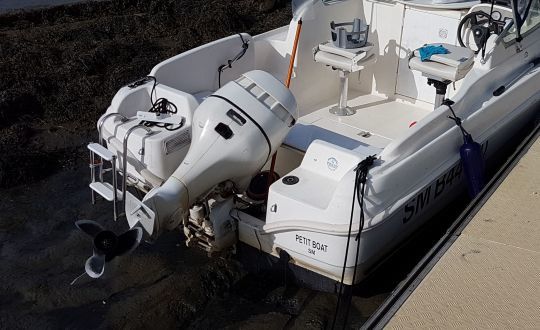
It is no longer possible to raise or lower the engine. At best, it remains in the down position and you can go back, at worst, it is in the up position. Of course, you have checked that the motor has not remained in the "transport" position and that the battery is well connected.
Solution: It is highly probable that a fuse has blown. This is the one that powers the trim motor. This is actually a pump that injects oil into the cylinders. Change the fuse. If it still doesn't work, the problem is hydraulic. All lifting mechanisms have a depressurization screw that allows you to remove the fluid from the cylinders and thus lower the engine. It is this screw that must be turned to lower the motor.
Prevention: Know in advance where this screw is located and examine the fluid level.

9 - The battery is no longer charging
No matter how much you sail, the battery remains permanently flat. There are two options: either the battery no longer absorbs the charge, or it no longer receives electricity.
Solution: Using a multimeter, test the voltage at the battery terminals when the motor is stopped (it should be around 13.5 V if it is fully charged) and when the motor is running (it should be close to 14 V).
If it is lower when the engine is stopped, the battery is at fault. If it is lower when the engine is running, the problem is with the alternator. In the first case, the battery will have to be replaced. In the second case, it is likely that the drive belt has failed. Look to see if the alternator is turning. If it's not moving or if you hear a rubbing noise, replace the belt. Don't drive the car then, because the water pump is also activated by the belt and you risk breaking the engine, which will then no longer be cooled.
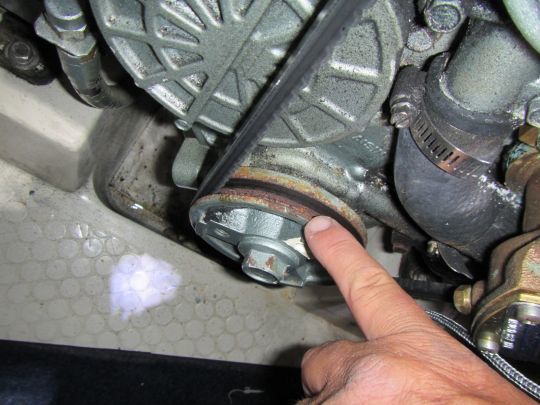
Prevention: In winter, store batteries in a warm place and keep them charged. At least every 2 seasons, replace the drive belts.
10 - Black/white/blue exhaust smoke
When running, an engine will smoke a little. However, it should not smoke "too much" and, above all, it should not produce thick smoke. The color of the smoke is important to observe:
- Black, it shows too much oil flowing into the two-stroke engine.
- Blue indicates that the engine is too hot.
- White, it highlights the presence of steam in the exhaust.
Solution: There is no other way than to ask for assistance. Insisting may result in engine failure, even if it's just too much oil in the mixture.
Prevention: Check the oil and water levels and follow the recommendations in the maintenance booklet supplied with your boat's engine.
